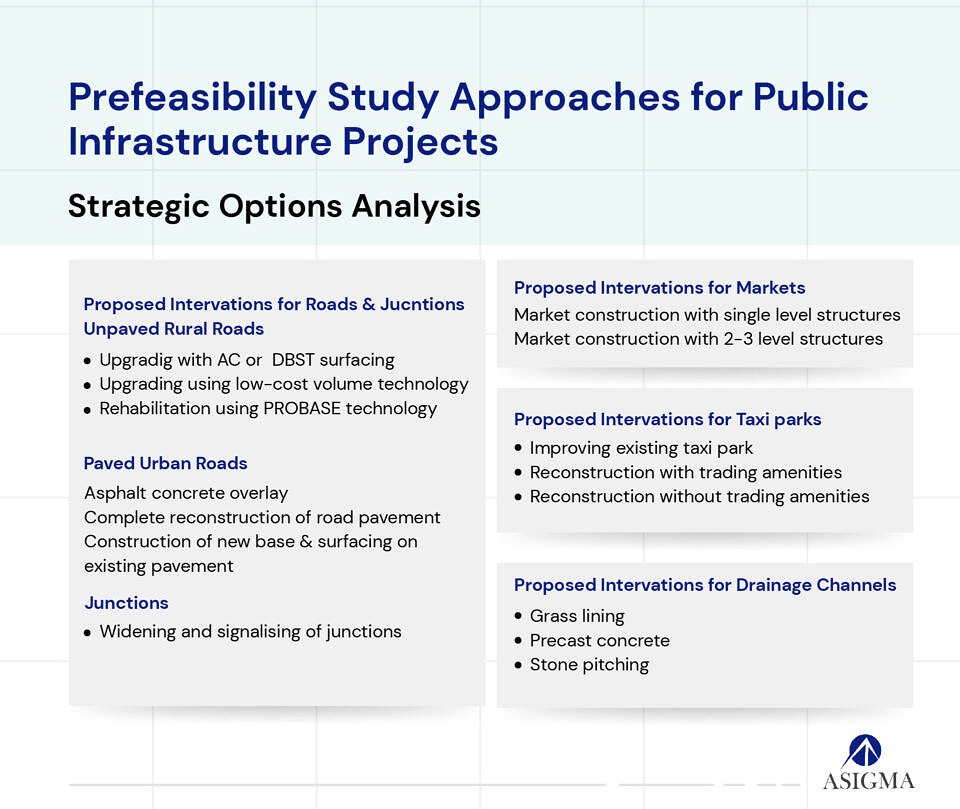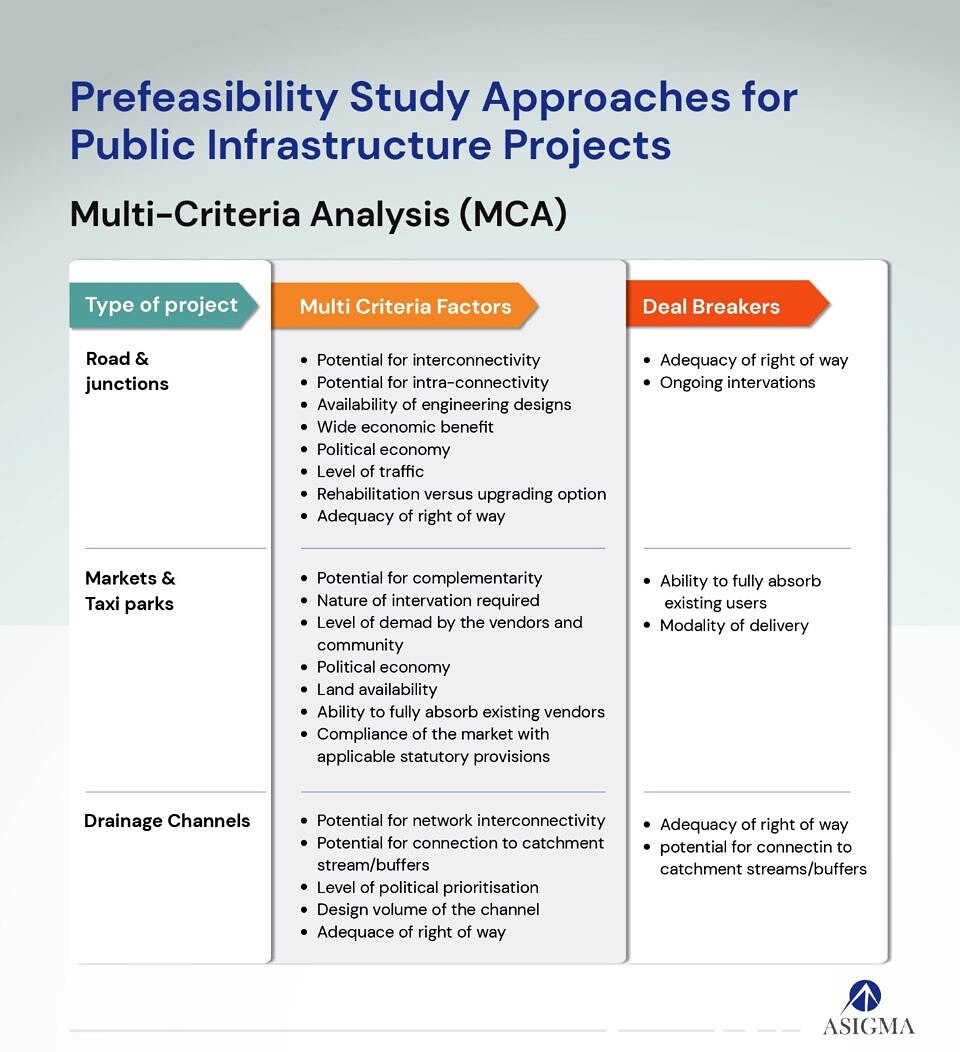Prefeasibility study approaches for public infrastructure projects
November 22, 2023

ASIGMA has conducted several prefeasibility studies in different sectors for government, private investors, as well as nonprofit organisations. One of the key areas that requires a unique and well-thought-out approach is the prefeasibility study of public infrastructure development for government due to its complexity and the involvement of many stakeholders. Public infrastructure consists of facilities and structures for public use such as roads, hospitals, and bridges.
Prefeasibility studies are preliminary assessments acting as a strategic filter to sift through a pool of potential projects. They identify the most promising ones before investing significant time and resources in detailed feasibility studies. Prefeasibility studies are essential precursors to more detailed feasibility studies, laying the foundation in developing public infrastructure projects. Since feasibility studies for public infrastructure projects are quite costly, it is crucial to select the most promising projects through prefeasibility studies. This process saves costs that would otherwise be spent on unviable projects. Prefeasibility studies quickly assess a project’s viability, considering economic, social, environmental, and technical aspects.
Typically, the government obtains a specific amount of funds earmarked for a portfolio of public infrastructure projects, such as a certain number of roads, hospitals, markets, bridges, among others. However, these government funds are usually less than the resources required to develop all earmarked projects. Consequently, prefeasibility studies enable the identification of the most promising projects for prioritisation. Our prefeasibility studies for government projects follow the Development Committee (DC) guidelines by the Ministry of Finance, Planning and Economic Development (MoFPED), which oversees Uganda’s Public Investment Plan.
In 2023, ASIGMA, in a joint venture with an engineering consultancy firm, was contracted to conduct a public infrastructure prefeasibility analysis. This project encompassed 610 km of roads, 19 junctions, 20 public markets, 8 drainage channels, and 4 taxi parks, all funded by the World Bank. The objective was to select the most promising projects for the available funds and determine the financial and economic returns to Ugandan citizens. This was crucial as the funds were not sufficient for all projects, and the government needed to focus on the most demanded projects with the highest financial and economic returns.
What was our approach for the study?
Our approach to the World Bank-funded public infrastructure project involved three key analyses: strategic options analysis, multi-criteria analysis and cost-benefit analysis.
The process began with a strategic options analysis, which determined possible interventions for each project category, including roads, junctions, markets, drainage systems and taxi parks. This was followed by a multi-criteria analysis to rank and select projects for the next step. This analysis considered key parameters such as public demand, land availability, and mode of delivery, among others. The subsequent step involved a cost-benefit analysis, determining the net benefits of the selected projects in monetary terms. This analysis was crucial for ranking and final selection based on the available funds. The projects that emerged from this process were then recommended for subsequent, more detailed feasibility studies. Our approach proved robust for the prefeasibility study, and the results received approval from all stakeholders.
Strategic Options Analysis
In the strategic options analysis phase, we evaluated at least two interventions for the development of each project. Our approach involved leveraging our deep understanding of global best practices. The technical team integrated these standards with the specific Ugandan context. This comprehensive approach encompassed technical specifications, political economy, regional balance, and environmental considerations, among other factors. Below are the proposed interventions for the projects, reflecting this multifaceted analysis.

During the strategic options analysis phase, we carefully evaluated a minimum of two possible interventions for each project. This process was underpinned by our extensive knowledge of global best practices. Our technical team adeptly melded these international standards with the unique context of Uganda. Our comprehensive approach took into account various critical factors, including technical specifications, the political economy, regional balance and environmental considerations, among others. The proposed interventions for the projects, which are detailed below, are a reflection of this thorough and multifaceted analysis.
Multi-Criteria Analysis (MCA)
Our multi-criteria analysis was anchored on a set of qualitative factors, which were collectively agreed upon by key stakeholders, including the client. In this phase, we conducted a thorough analysis of the strengths and weaknesses of the projects under each proposed intervention. Projects that failed to meet the minimum requirements based on these factors were systematically eliminated. We considered a variety of factors for each type of project within the multi-criteria analysis. These factors are concisely summarised in the table provided below:
The level of demand by users in the nearby communities was assigned the highest weighting in our analysis. This prioritisation is crucial to ensure the development of projects that genuinely satisfy community needs, thereby preventing the creation of ‘white elephants’. Projects that successfully passed the multi-criteria analysis (MCA) were then advanced to the cost-benefit analysis phase. This next step was essential to determine the most promising projects based on their potential benefits. The outcomes of the MCA led to the selection of the following number of projects.
Cost Benefit Analysis (CBA)
We employed a systematic cost-benefit analysis (CBA) to rigorously evaluate the net benefits (benefits minus costs) of each project. This analysis involved a detailed comparison of the costs incurred in developing the projects against their anticipated benefits. The primary goal of the cost-benefit analysis was to identify the most advantageous sub-projects for consideration. During this analysis, we developed comprehensive financial and economic models. These models were instrumental in calculating key metrics such as the net present value (NPV) and internal rate of return (IRR) for each sub-project, thereby providing a quantifiable measure of net benefits.
Conclusion
Conclusions were drawn by ranking the projects using both net present value (NPV) and internal rate of return (IRR) and the best-ranked projects that fitted in the available funds were selected for further feasibility studies.
The final selection of projects was analysed to have an economic IRR of 22.94%.
The findings from the analysis indicated that setting up public infrastructure in the GKMA region was economically viable but (in most instances) not financially viable. However, the government’s investment in public infrastructure is not for financial gains but economic gains.
